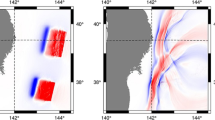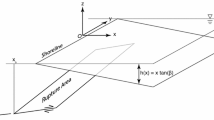Abstract
The 25 April 1992 Cape Mendocino earthquake generated a tsunami characterized by both coastal trapped edge wave and non-trapped tsunami modes that propagated north and south along the U.S. West Coast. Both observed and synthetic time series at Crescent City and North Spit are consistent with the zero-order edge wave mode solution for a semi-infinite sloping beach depth profile. Wave amplitudes at Crescent City were about twice that observed at North Spit, in spite of the fact that the source region was three times farther from Crescent City than North Spit. The largest observed amplitude was due to an edge wave which arrived almost three hours after the initial onset of the tsunami; since such waves are highly localized nearshore, this suggests that the enhanced responsiveness at Crescent City is at least partly due to local dynamic processes. Furthermore, the substantially delayed arrival of this wave, which was generated at the southern end of the Cascadia Subduction Zone, has significant implications for hazard mitigation efforts along the entire U.S. West Coast. Specifically, this study demonstrates that slow-moving but very energetic edge wave modes could be generated by future large tsunamigenic earthquakes in the CSZ, and that these might arrive unexpectedly at coastal communities several hours after the initial tsunami waves have subsided.
Similar content being viewed by others
References
Atwater, B. F. (1987),Evidence for Great Holocene Earthquakes Along the Outer Coast of Washington State, Science236, 942–944.
Ball, F. K. (1967),Edge Waves in an Ocean of Finite Depth, Deep-Sea Res.14, 79–88.
Bernard, E. N., González, F. I., Sigrist, D., Tsuruya, H., Kato, K., Shuto, N., Matsutomi, H., Tsuji, Y., Ito, H., Yamamoto, K., Iwasaki, Y., Sasaki, K., Hattori, A., Suzuki, Y., Takahashi, S., Goto, C., Hashimoto, N., Hosoyamada, T., Nagao, T., Mizuno, Y., Yano, K., Nagaoka, O., Honda, S., andTatehata, H. (1993),Tsunami Devastates Japanese Coastal Region, EOS', Trans. Am. Geophys. Union74, pp. 417 and 432.
Braddock, R. D. (1969),On Tsunami Propagation, J. Geophys. Res.74, 1952–1957.
Dziewonski, A. S. (1969),A Technique for the Analysis of Transient Seismic Signals, Bull. Seismol. Soc. Am.59, 427–444.
Eckart, C.,Surface Waves in Water of Variable Depth, Scripps Institution of Oceanography Wave Report 100 (1951).
Fuller, J. D., andMysak, L. A. (1977),Edge Waves in the Presence of an Irregular Coastline, J. Phys. Ocean7, 846–855.
Greenspan, H. P. (1956),The Generation of Edge Waves by Moving Pressure Distributions, J. Fluid Mech.,1, 574–592.
Hammack, J. L. (1973),A Note on Tsunamis: Their Generation and Propagation in an Ocean of Uniform Depth, J. Fluid Mech.60, 769–799.
Hatori, H.,Distribution of tsunami energy on the circum-Pacific zone InProceedings, IUGG/IOC International Tsunami Symposium (Wakayama, Japan, 1993).
Heaton, T. H., andHartzell, S. H. (1987),Earthquake Hazards on the Cascadia Subduction Zone, Science236, 162–168.
Houston, J. R., andGarcia, A. W. (1978),Type 16 Flood Insurance Study: Tsunami Predictions for the West Coast of the Continental United States, U.S. Army Engineer Waterways Experiment Station Technical Report H-78-26.
Hwang, L.-S., Butler, H. L., andDivoky, D. J. (1972),Tsunami Model: Generation and Open-sea Characteristics, Bull. Seismol. Soc. Am.62, 1579–1596.
Kanamori, J., andKikuchi, M. (1993),The 1992 Nicaragua Earthquake: A Slow Tsunami Earthquake Associated with Subducted Sediments, Nature361, 714–716.
Leblond, P. H., andMysak, L. A., Waves in the Ocean (Elsevier Scientific Publishing Company, 1978).
Mei, C. C.,The Applied Dynamics of Ocean Surface Waves (John Wiley and Sons, 1983).
Munk, W. H., Snodgrass, F. E., andCarrier, G. (1956),Edge Waves on the Continental Shelf, Science123, 127–132.
Okada, Y. (1985),Surface Deformation due to Shear and Tensile Faults in a Half-space, Bull. Seismol. Soc. Am.,75, 1135–1154.
Oppenheimer, D., Beroza, G., Carver, G., Dengler, L., Eaton, L., Gee, L., González, F., Jayko, A., Li, W. H., Lisowski, M., Magee, M., Marshall, G., Murray, M., McPherson, R., Romanowicz, B., Satake, K., Simpson, R., Somerville, P., Stein, R., andValentine, D. (1993),The Cape Mendocino, California, Earthquake of April 1992: Subduction at the Triple Junction, Science261, 433–438.
Roberts, J. A., andChien, C.-W. (1964),The Effects of Bottom Topography on the Refraction of the Tsunami of 27–28 March 1964: The Crescent City Case, Meteorology Research, Inc. Report.
Satake, K. (1995),Linear and Nonlinear Computations of the 1992 Nicaragua Earthquake Tsunamis, Pure and Appl. Geophys., this volume.
Satake, K., Bourgeois, J., Abe, K., Tsuji, Y., Imamura, F., Iio, Y., Katao, H., Noguera, E., andEstrada, F. (1993),Tsunami Field Survey of the 1992 Nicaragua Earthquake, EOS, Trans. Am. Geophys. Union74, pp. 74, 145 and 156–147.
Stokes, G. G. (1846),Report on Recent Researches in Hydrodynamics, 16th Meeting Brit. Assoc. Adv. Sci., 1–20.
Ursell, F. (1952),Edge Waves on a Sloping Beach, Proc. R. Soc. Lond.A214, 79–97.
Weaver, C. S., andShedlock, K. M. (1992),Estimates of Seismic Source Regions from Consideration of the Earthquake Distribution and Regional Tectonics in the Pacific Northwest, U.S. Geological Survey, Open-File Report 91-441.
Whitmore, P. M. (1993),Expected Tsunami Amplitudes and Currents along the North American Coast for Cascadia Subduction Zone Earthquakes, Natural Hazards8, 59–73.
Wiegel, R. L. (1976),Tsunamis. InSeismic Risk and Engineering Decisions (eds. Lomnitz, C., and Rosenblueth, E.) (Elsevier Scientific Publishing Company, Amsterdam, 1976), pp. 225–286.
Wilson, B. W., andTorum, A. (1968),The Tsunami of the Alaskan Earthquake, 1964, U.S. Army Corps of Engineers Coastal Engineering Research Center Technical Memorandum25.
Yeh, H., Imamura, F., Synolakis, C., Tsuji, Y., Liu, P., andShi, S. (1993),The Flores Island Tsunamis, EOS, Trans. Am. Geophys. Union74, pp. 369 and 371–372.
Author information
Authors and Affiliations
Rights and permissions
About this article
Cite this article
González, F.I., Satake, K., Boss, E.F. et al. Edge wave and non-trapped modes of the 25 april 1992 Cape Mendocino tsunami. PAGEOPH 144, 409–426 (1995). https://doi.org/10.1007/BF00874375
Received:
Revised:
Accepted:
Issue Date:
DOI: https://doi.org/10.1007/BF00874375




